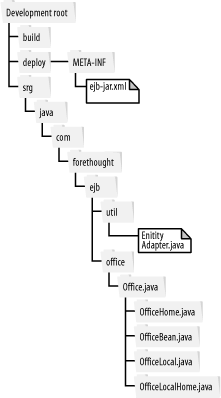At this point, you’ve completed the code for your entity bean, and now you need to deploy the bean. This involves creating a deployment descriptor for the bean and then wrapping the entire bean into a deployable unit. I’ll cover each of these steps in the following sections.
To
wrap
all these classes into a coherent unit, you must create an
XML deployment descriptor. These
descriptors replace the horrible serialized deployment descriptors
from EJB 1.0. XML deployment descriptors eliminate one
vendor-dependent detail: the descriptor is standardized across all
application servers. Notice that the
document type
definition (DTD) referred to in the
DOCTYPE
declaration refers to a Sun file, ensuring that no vendors add their
own tags or extensions to the descriptor. If your server requires you
to use a different DTD, you may have a serious problem on your hands;
you may want to consider switching to a standards-based application
server immediately. And if DTDs, elements, tags, and these other XML
terms are Greek to you, pick up Java and XML(O’Reilly), by yours truly, to get
answers to your XML-related questions.
Example 4-7, the deployment descriptor for the
office entity bean, contains entries only for that bean, detailing
its home, remote, implementation, and primary key classes. These are
all required elements for an entity bean, as is specifying that the
bean is not reentrant and specifying the persistence type, which in
our case is container-managed. Later on, we’ll add
entries for numerous other entity beans that we will code and add to
the application. Because we are deploying a CMP bean, the fields that
must be handled by the container are listed; in this case, these are
all the fields in the OfficeBean class. We also
give the bean a name to be used, OfficeBean.
If you are familiar with EJB deployment descriptors, you might notice
that I have left out the assembly-descriptor
element and related subelements that allow permission specification
for beans and their methods. That’s so you can focus
on the bean right now, and deal with security later.
Don’t worry, though; I’ll get to
all of this before we’re done with our application.
Leaving it out for now will allow the container to generate default
permissions.
Example 4-7. The Office Entity Bean Deployment Descriptor
<?xml version="1.0"?>
<!DOCTYPE ejb-jar
PUBLIC "-//Sun Microsystems, Inc.//DTD Enterprise JavaBeans 2.0//EN"
"http://java.sun.com/dtd/ejb-jar_2_0.dtd">
<ejb-jar>
<enterprise-beans>
<entity>
<description>
This Office bean represents a Forethought office,
including its location.
</description>
<display-name>OfficeBean</display-name>
<ejb-name>OfficeBean</ejb-name>
<home>com.forethought.ejb.office.OfficeHome</home>
<remote>com.forethought.ejb.office.Office</remote>
<local-home>com.forethought.ejb.office.OfficeLocalHome</local-home>
<local>com.forethought.ejb.office.OfficeLocal</local>
<ejb-class>com.forethought.ejb.office.OfficeBean</ejb-class>
<persistence-type>Container</persistence-type>
<prim-key-class>java.lang.Integer</prim-key-class>
<reentrant>False</reentrant>
<abstract-schema-name>OFFICES</abstract-schema-name>
<cmp-field><field-name>id</field-name></cmp-field>
<cmp-field><field-name>city</field-name></cmp-field>
<cmp-field><field-name>state</field-name></cmp-field>
<primkey-field>id</primkey-field>
</entity>
</enterprise-beans>
</ejb-jar>Warning
A word to the wise here: it might seem that the XML would be clearer
with some reorganization. For example, the
prim-key-class element might be easier to find if
it were right below the other class entries (home,
remote, and ejb-class).
However, moving it will cause an error in deployment! The ejb-jar_2_0.dtd
file specifies the order of elements, and
is completely inflexible in this respect. This is a typical
limitation of DTDs, as opposed to other constraint representations in
XML such as XML Schemas. If these elements not in the correct order
shown in the example, you will encounter errors in deployment.
The process of creating the Office entity bean is finally complete
(at least in its current form). You now need to create a deployable
JAR file, and then create the
container classes to add implementation details to your bean, such as
SQL and JDBC code. First, ensure that your directory structure is set
up correctly. The Java source files can all be in a top-level
directory. You should then create a directory called
META-INF/, and place the
ejb-jar.xml
deployment descriptor
inside it. Next, compile your source files:
galadriel:/dev/javaentI $ javac -d build \
ch04/src/java/com/forethought/ejb/util/*.java \
ch04/src/java/com/forethought/ejb/office/*.javaTip
Setting up your classpath for these compilations can be either really simple or really difficult. Many application servers provide a script that can be run to set up all the environment variables. Running this script takes care of all the classpath issues for you, and your compilations will be a piece of cake (refer to Appendix D and Appendix E for these details for the Sun J2EE reference implementation). Or, you may have to manually add the entries needed to your classpath. You should consider creating your own script in these cases, and then bothering your server vendor until they provide you with a prebuilt script. Unfortunately, the libraries are packaged differently with every server (for example, in Weblogic there is one giant JAR, and in jBoss there are individual JARs for each API), so I can’t tell you exactly what to type. Just look for a script; it’s almost always there.
Correct any errors you receive by referring to the text. Once
you’ve compiled the source, you should have the
directory structure shown in Figure 4-2. Notice
that I have build/ and
deploy/
directories in place before
compilation and deployment to segregate my files. You should create
these as well (or use your own structure, of course).
Next, you need to create a JAR file of these classes and the
deployment descriptor. Create it with the name
forethoughtEntities.jar, as shown:
galadriel:/dev/javaentI $ cd build
galadriel:/dev/javaentI/build $ jar cvf ../deploy/forethoughtEntities.jar com \
META-INF/ejb-jar.xml
added manifest
adding: com/(in = 0) (out= 0)(stored 0%)
adding: com/forethought/(in = 0) (out= 0)(stored 0%)
adding: com/forethought/ejb/(in = 0) (out= 0)(stored 0%)
adding: com/forethought/ejb/office/(in = 0) (out= 0)(stored 0%)
adding: com/forethought/ejb/office/Office.class(in = 439) (out= 280)(deflated
36%)
adding: com/forethought/ejb/office/OfficeBean.class(in = 805) (out= 445)
(deflated 44%)
adding: com/forethought/ejb/office/OfficeHome.class(in = 480) (out= 260)
(deflated 45%)
adding: com/forethought/ejb/util/(in = 0) (out= 0)(stored 0%)
adding: com/forethought/ejb/util/EntityAdapter.class(in = 831) (out= 388)
(deflated 53%)
adding: META-INF/ejb-jar.xml(in = 1038) (out= 430)(deflated 58%)With this archive ready for use, you can refer to Appendix D for instructions on taking the JAR from its current state to a deployable, CMP entity bean and descriptor.
Get Building Java Enterprise Applications now with the O’Reilly learning platform.
O’Reilly members experience books, live events, courses curated by job role, and more from O’Reilly and nearly 200 top publishers.


